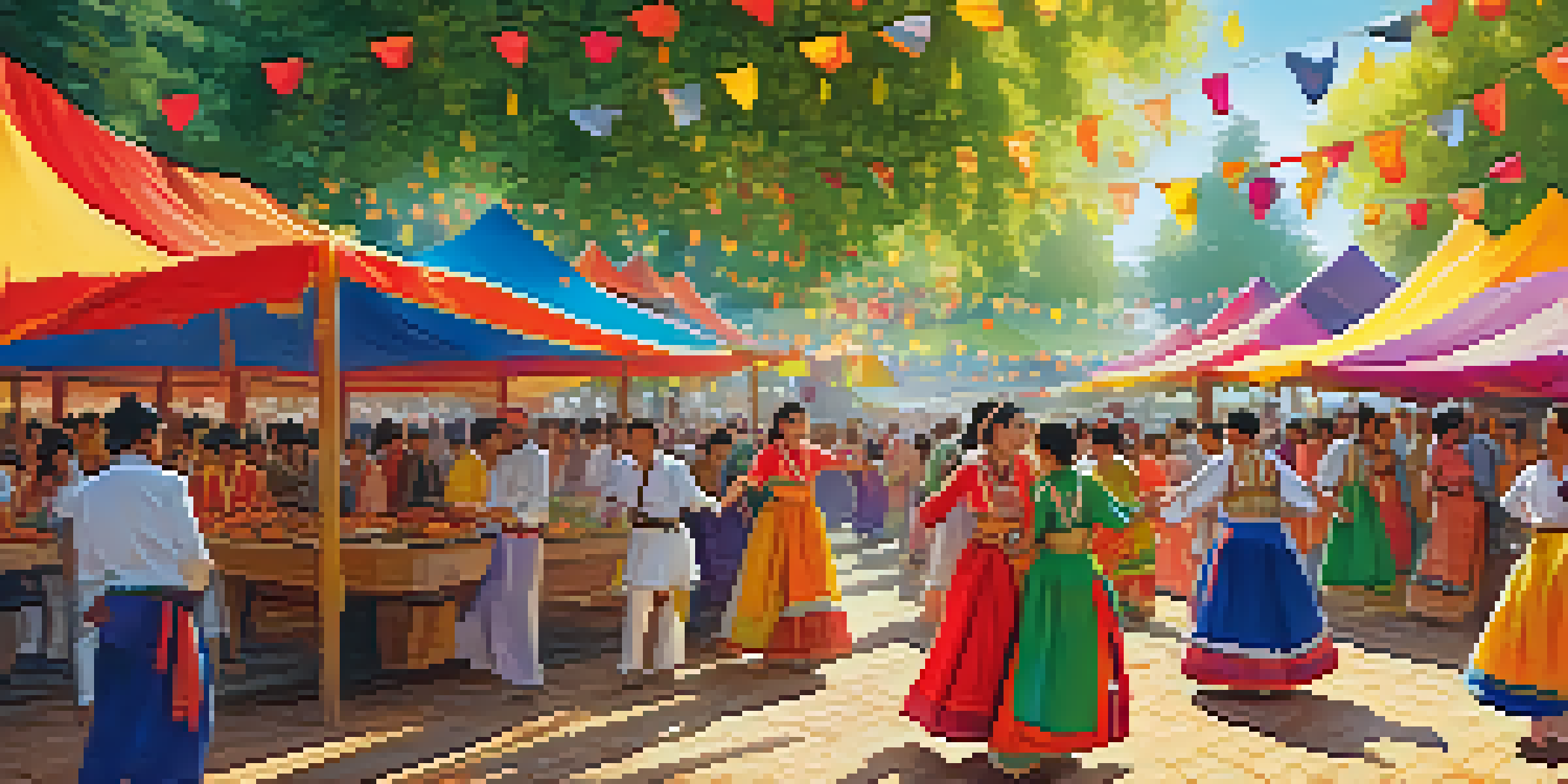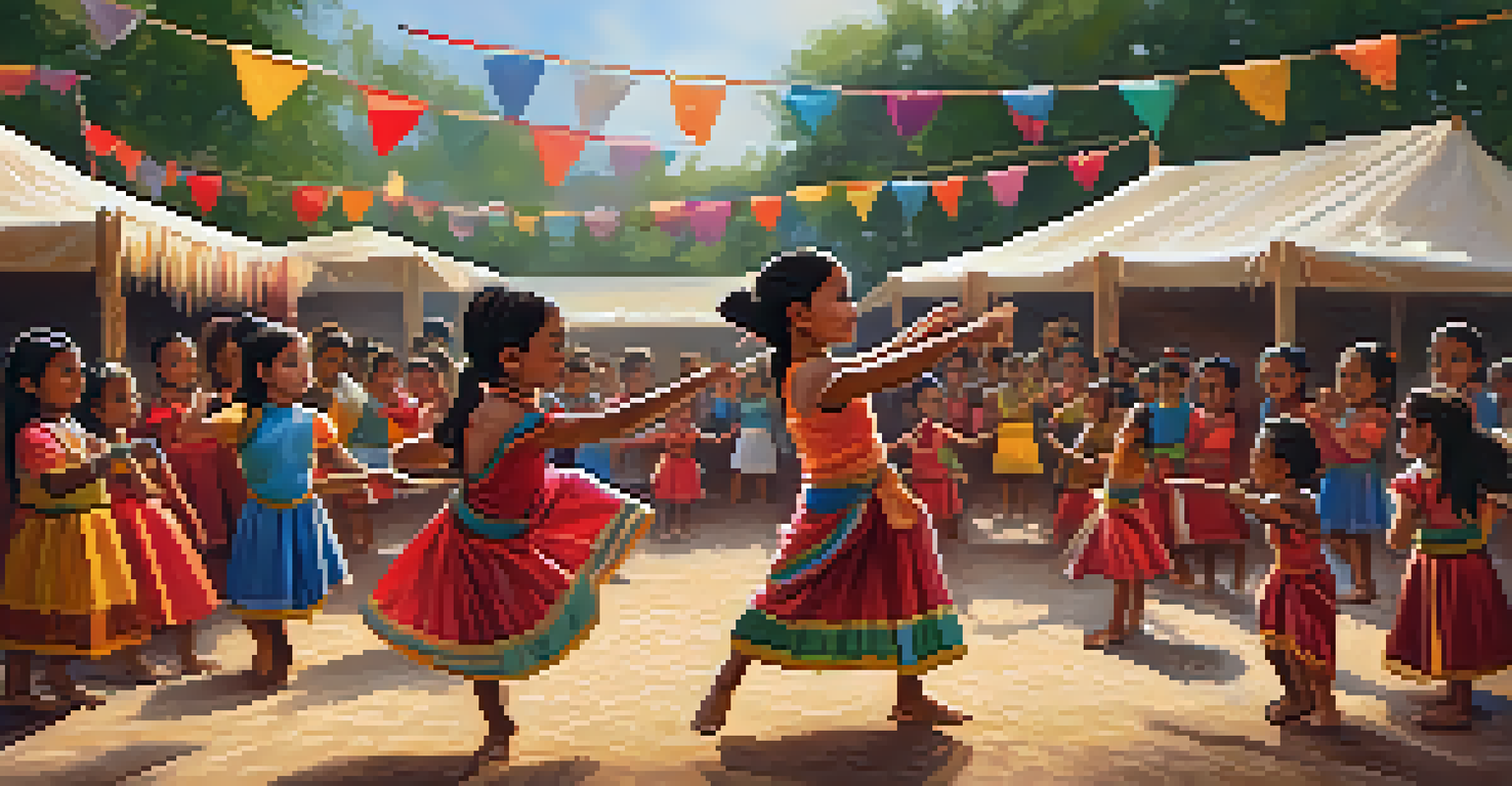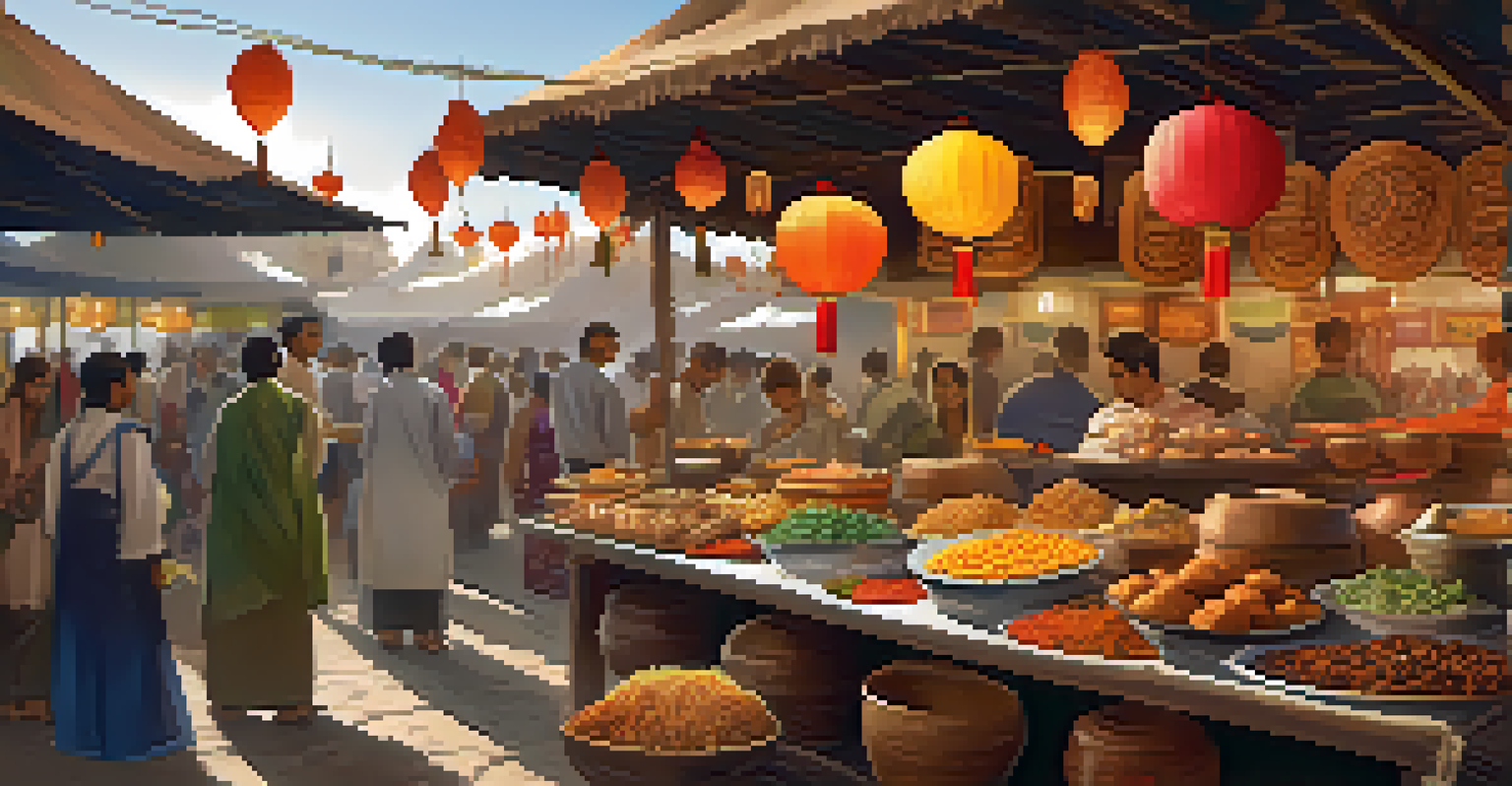Cultural Festivals: Celebrating Dance and Music Together

The Essence of Cultural Festivals and Their Significance
Cultural festivals are vibrant gatherings that celebrate the rich traditions of a community. They often showcase the unique dance forms and musical styles that define a culture, creating an immersive experience for attendees. These events are not just about entertainment; they serve as a platform for cultural expression, fostering a sense of identity and belonging.
Cultural festivals are a celebration of life, and they help to preserve the diversity of our world.
One of the most profound aspects of these festivals is their ability to bring people together, transcending language and geographical barriers. When music and dance intertwine, they create an emotional connection that resonates deeply, allowing individuals to share in the joy of collective celebration. In essence, cultural festivals become a living tapestry of stories, history, and shared experiences.
Moreover, participating in these festivals can deepen our understanding of different cultures. By witnessing traditional dances or listening to folk music, we gain insights into the values and beliefs of others, fostering respect and appreciation. This exchange is essential in our increasingly globalized world, where celebrating diversity is more important than ever.
Dance: The Heartbeat of Cultural Celebrations
Dance is often seen as the heartbeat of cultural festivals. Each movement tells a story, reflecting the heritage and emotions of the people. From the energetic samba of Brazil to the graceful hula of Hawaii, dance forms are deeply rooted in the history and traditions of their communities.

At these festivals, dance becomes a communal activity, inviting participation from everyone, regardless of skill level. This inclusivity transforms the atmosphere, as people join hands and share in the joy of movement. It's not just about the performance; it's about the connections made on the dance floor, where strangers become friends.
Cultural Festivals Unite Communities
Cultural festivals foster a sense of identity and belonging by bringing people together to celebrate diverse traditions.
In addition, dance performances at cultural festivals often incorporate traditional costumes and instruments, enriching the sensory experience. The visual and auditory elements combine to create a captivating spectacle that transports the audience to another time and place. This integration of dance and culture helps preserve traditions while making them accessible to new generations.
Music: The Soul of Cultural Festivals
Music serves as the soul of cultural festivals, providing the soundtrack that accompanies dance and celebration. It has the unique ability to evoke emotions, create memories, and unite people in shared experiences. Each festival showcases its own musical heritage, from folk tunes to contemporary rhythms, making it a vibrant expression of cultural identity.
Music is the universal language of mankind.
Live performances are often the highlight of these festivals, with musicians captivating audiences with their talent and passion. The sounds of traditional instruments, whether it's the sitar in India or the djembe in West Africa, resonate with authenticity and history. These performances invite attendees to lose themselves in the rhythm and feel the pulse of the culture.
Moreover, music at cultural festivals often encourages participation, with sing-alongs and communal dancing that create a sense of belonging. It's a reminder that music is not just for listening; it's for experiencing together. In this way, festivals become a celebration of community, where everyone can join in and contribute to the joyful atmosphere.
The Role of Food in Cultural Festivals
Food plays a pivotal role in cultural festivals, complementing the dance and music that define the celebrations. Each dish tells a story, representing the flavors and culinary traditions of the culture. From spicy street food to elaborate feasts, the variety of cuisines on display invites everyone to taste and explore.
At these festivals, food is not just sustenance; it becomes an integral part of the experience. Sharing a meal with others fosters connections and builds relationships, as people gather around tables and engage in conversation. The act of breaking bread together can be a powerful way to celebrate unity and diversity.
Dance and Music Enhance Experiences
Dance and music serve as powerful expressions of cultural identity, enhancing the emotional and sensory experiences of festival attendees.
Additionally, food stalls often feature cooking demonstrations and workshops, allowing attendees to learn about traditional recipes and cooking techniques. This interactive element enriches the festival experience, ensuring that the culinary arts are appreciated alongside music and dance. In this way, food becomes a bridge connecting past and present, tradition and innovation.
Promoting Cultural Awareness Through Festivals
Cultural festivals serve as vital platforms for promoting cultural awareness and appreciation. They invite individuals from all backgrounds to experience and learn about different traditions, fostering a greater understanding of the world around us. This exposure is crucial in combating stereotypes and encouraging respect for diverse cultures.
By participating in these festivals, attendees gain insights into the values, beliefs, and histories of various communities. This firsthand experience helps break down barriers and builds empathy, essential for creating harmonious societies. Festivals become not just celebrations but also educational opportunities for everyone involved.
Moreover, cultural festivals often collaborate with local schools and organizations to engage younger generations. Through workshops, performances, and storytelling, children learn about their heritage and the importance of preserving cultural practices. This investment in the future ensures that the spirit of these festivals continues to thrive for years to come.
The Impact of Technology on Cultural Festivals
In recent years, technology has transformed the way cultural festivals are experienced and celebrated. Social media platforms allow for real-time sharing of performances and highlights, enabling a broader audience to engage with the festivities. This digital presence can significantly enhance the visibility of cultural events, attracting more attendees.
Additionally, technology has made it easier for festival organizers to reach global audiences through live streaming. People from around the world can participate in these celebrations, even if they cannot physically attend. This inclusivity promotes cultural exchange and allows for a richer experience as diverse voices come together in the digital landscape.
Food Connects Cultures and People
Food plays a vital role in cultural festivals, offering a delicious way to explore culinary traditions and foster connections among attendees.
However, while technology offers many benefits, it also poses challenges. Balancing the digital experience with the authentic atmosphere of in-person celebrations is crucial. Organizers must find ways to enhance the festival experience without overshadowing the cultural elements that make these events special.
Future Trends in Cultural Festivals
As we look to the future, cultural festivals are evolving to reflect changing societal values and trends. Sustainability is becoming a priority, with many festivals adopting eco-friendly practices to minimize their environmental impact. This shift not only aligns with global efforts to combat climate change but also resonates with attendees who value responsible tourism.
Moreover, there is a growing emphasis on inclusivity and representation within cultural festivals. Organizers are making concerted efforts to feature diverse artists and performers, ensuring that various voices and traditions are celebrated. This evolution enriches the festival experience and fosters a sense of belonging for all attendees.

Finally, the fusion of different cultural elements is becoming more common, leading to innovative performances and collaborations. As cultures blend and interact, festivals will continue to be dynamic spaces for creativity and expression. This trend not only keeps traditions alive but also allows for the exploration of new artistic frontiers, ensuring that cultural festivals remain vibrant and relevant.